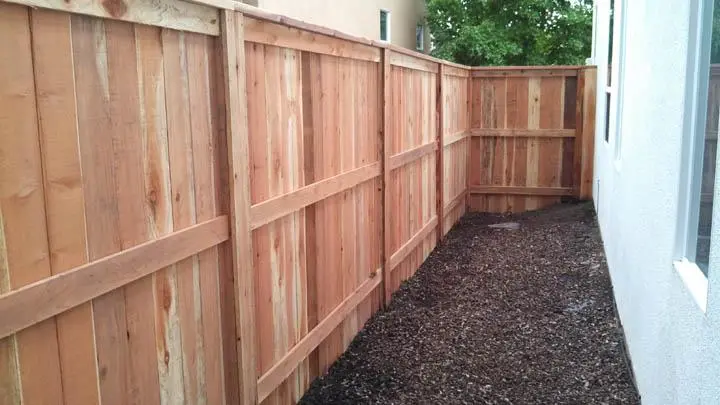It can be frustrating when you look out in your yard one day to discover your previously straight wood fence is now leaning. In this article we are going to learn what causes a leaning fence and also how to fix a falling fence. There are a few common culprits, from loose fence posts to rotten and snapped off post. The good news is there are ways to fix a leaning fence without replacing the whole thing if you catch the problem early enough. Here’s what you need to know.
What Causes a Fence to Lean?
- Rotting or loose fence posts
- Soil erosion around posts or settling soil
- Poor Installation of current fence posts
- Environmental factors (tree roots, vehicle damage, tree falling)
- Incorrect post hole depth or concrete footing issue
- Age-related damage to wood boards and pickets
- Sprinklers watering the fence
Can a Leaning Fence Be Repaired Without Replacing?
In many cases, yes! As long as the posts and foundation of your wood fence are still intact and salvageable, you can usually correct leaning and sagging issues without replacing the entire fence. It may take some work, but it’s very doable.
How to Repair a Falling Fence
Recommended– Option 1- ADD TEMPORARY BRACES: Before tackling permanent fence repairs, temporarily brace sagging posts with new wood or metal posts for safety. Drive stakes next to tilted posts and secure boards with sturdy brackets or rope. The advantage to this type of repair is that you do NOT need to remove the old post and concrete mix in the ground because you are going to set new posts to the side of the current posts (not in the same place). The disadvantage of this type of fence post repair is that the new support posts will many times be visible and stand out from the rest of the fence (depending on the style). This is a more temporary fix.
Recommended — BEST SOLUTION– Option 2- FENCE POST REPLACEMENT: This solution is the more proper way to re-support a post that has rotten and failing posts. This entails cutting the old fence post from the from the panels then digging out the posts and concrete and replacing with a new post in the same exact place as the old one. Last you would then connect the fence panels back to this new / strong fence post. The advantage of this is that this is the most correct way of re-supporting a falling fence, but the disadvantage is that it is more labor to complete a post replacement like this. This is a true long term solution.
NOT Recommended — Option 3 – Post Mender: A post mender is a bracket that helps reinforce rotted or damaged 4×4 wood posts. The concept is that you hammer the metal post into the ground securing it next to the rotten post. Next you attach this metal “splint” to the post above the rotten area. While it works successfully sometimes, we too often see them in the field not working well. Hence we have chosen to not recommend them.
5 Steps to Fix a Leaning Wood Fence:
- Locate the loose fence posts. Can you figure out why it is leaning? This will tell you what you need to do to remedy the situation. If you can’t determine the root of the problem with your fence or think the issue may be too big to tackle on your own, contact a fencing company like us!
- Backfill eroded soil around posts to stabilize.
- Add support bracing to hold up the fence and relieve pressure while you complete the fence repair
- Check for a concrete footing on the current posts and cut the rails and panels free from the leaning or rotten posts (if replacing the post option #2 above)
- Replace the broken fence posts with a brand new post in the same location as the current (option #2) or Add new support posts next to the current posts (option #1). In both of these situations set these new posts 2 feet deep in fast setting concrete.
When to Call a Professional
Making the decision on when to call a professional fence company to repair your leaning fence is different for each person. Some homeowners will want to attempt a fence repair including replacing a leaning fence post or two. When you get to the point of calling a fence installation company we are excited to professionally repair or replace your fence. Wee will give you our best advice on your options to how to repair your fence in the short terms and long term.
How Fence Posts Should Properly Be Installed
Many homeowners have experienced the frustration of installing a new fence, only to have the posts start leaning. Oftentimes, this issue can be traced back to the depth of the posts not being set deep enough. Common practice is to setup wood, metal, or vinyl fence posts at least 1/3 of their total height into a concrete footing to provide adequate stability. For example, a 6 foot privacy fence should have its posts embedded 2 feet into a concrete footing.
Unfortunately, in an effort to save time or money, some installers fail to follow this rule of thumb when setting posts. Or perhaps the concrete footings weren’t allowed to properly cure before fence panels were attached, weakening the anchors. Regardless of the reason, insufficient post depth results in loosening and eventual leaning as lateral forces act upon the fence from wind, soil movement, people leaning on it, etc. A little wobble quickly compounds into very noticeable leaning posts and sagging fence lines – significantly shortening the lifespan of the fence and detracting from curb appeal.
The good news is fence posts that are leaning due to inadequate footings can be remedied, although it often requires removing these posts. Consulting with a knowledgeable fencing contractor like Fantastic Fence on proper post depth specifications during initial installation is wise to avoid the headaches of a sinking fence down the road. Installing fence posts the right way the first time saves money and frustration compared to rebuilding sagging runs of fence.
What are Not Recommended to Repair Fence Posts
Metal Fence Menders- Based on what we have seen in yards through the years we do NOT recommend metal support stakes that are driven alongside the post and then secured to the posts in an attempt to “splint” the rotten or broken fence post. In our experience these support braces are NOT as consistently effective as we would expect.
Expanding Foam– We have had some customers recently ask us about using expanding foam when fixing their fence posts. We have actually not seen it used in our Sacramento area as of yet but in researching it there are some upsides and downsides. One positive is that expanding foam cures(hardens) faster than concrete. While it reported to work ok for lightweight mesh or vinyl fences, we have not seen it recommended for heavier fences like wood privacy fences. We currently do NOT recommend expanding foam to secure your new fence posts, but instead to use fast setting cement because it is more durable for heavier fences, costs less, and is a more tested solution.
Fence Maintenance
The smartest property owners inspect and maintain their fences on a regular maintenance (at least once per year). By implementing checking your fence regularly with annual inspections and maintenance of your fence at least once per year, it will keep a fence standing straight and strong for years to come. During your inspection you should be looking for rot, damage, rust, and any loose pieces . Latches and hinges should be oiled and free of rust. By keeping a well-maintained fence, you can avoid costly replacement for years to come!
Conclusion:
Doing this hard work on the foundation, posts, and braces will often straighten a leaning wood fence without requiring full replacement. However, if the leaning issues persist after trying these corrective measures, then the entire fence may need to be swapped out down the road. Catching problems early makes fixes much easier.
I hope this gives you a good action plan to restore straightness to your leaning fence. Let me know if you need any other specific information as you work to improve your fence stability.

